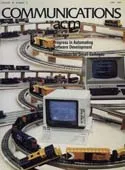June 1985 - Vol. 28 No. 6

Features
Toward automating the software-development cycle
Knowledge-intensive rather than labor-intensive processes are being advanced to spur programming productivity.
On time and space decomposition of complex structures
Models of large and complex systems can often be reduced to smaller sub-models, for easier analysis, by a process known as decomposition. Certain criteria for successful decompositions can be established.
Computing programs in small colleges
This Summary Report of The ACM Small College Task Force outlines resources, courses, and problems for small colleges developing degree programs in computing.
Data compression using static Huffman code-decode tables
Both static and dynamic Huffman coding techniques are applied to test data consisting of 530 source programs in four different languages. The results indicate that, for small files, a savings of 22-91 percent in compression can be achieved by using the static instead of dynamic techniques.
A generalized user interface for applications programs (II)
A display-screen management system for user interaction with an arbitrary application program is simple enough so that the end user controls the dialogue and screens yet powerful enough to provide for user specification of screen geometry, input constraints, computation facilities, and display logic—quite independently of the application system.
Natural language with discrete speech as a mode for human-to-machine
A voice interactive natural language system, which allows users to solve problems with spoken English commands, has been constructed. The system utilizes a commercially available discrete speech recognizer which requires that each word be followed by approximately a 300 millisecond pause. In a test of the system, subjects were able to learn its use after about two hours of training. The system correctly processed about 77 percent of the over 6000 input sentences spoken in problem-solving sessions. Subjects spoke at the rate of about three sentences per minute and were able to effectively use the system to complete the given tasks. Subjects found the system relatively easy to learn and use, and gave a generally positive report of their experience.
A randomized protocol for signing contracts
Randomized protocols for signing contracts, certified mail, and flipping a coin are presented. The protocols use a 1-out-of-2 oblivious transfer subprotocol which is axiomatically defined.The 1-out-of-2 oblivious transfer allows one party to transfer exactly one secret, out of two recognizable secrets, to his counterpart. The first (second) secret is received with probability one half, while the sender is ignorant of which secret has been received.An implementation of the 1-out-of-2 oblivious transfer, using any public key cryptosystem, is presented.



